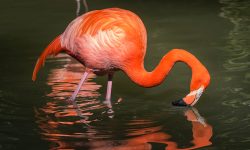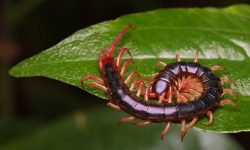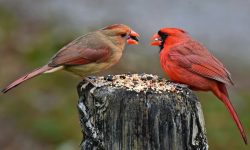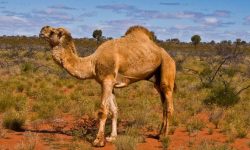Doves are gentle, graceful birds commonly associated with peace, calmness and soft cooing songs that echo through parks, forests and neighborhoods. These birds exist in many parts of the world, adapting well to both wild and suburban environments. Understanding what doves eat provides insight into how they survive season changes, migrate, raise chicks and maintain their daily energy needs. While they appear delicate, doves are resilient foragers with a surprisingly varied natural diet.
Their feeding habits revolve around seeds, fruits and occasional insects. With small, slender beaks and agile bodies, doves forage mostly on the ground or low vegetation. They gather in open fields, woodland edges, grasslands or backyard lawns to search for food. Their diet shifts with seasons, changing plant availability and nesting cycles. Warm months usually provide abundant seeds and insects, while winter requires doves to rely more heavily on dried seeds and leftover berries still hanging on shrubs.
This guide explores 20 foods doves love in the wild, highlighting the nutritional sources that help them survive across different landscapes. Their food choices reflect the adaptability that makes doves common yet important birds in many ecosystems.
Understanding the Dove Diet
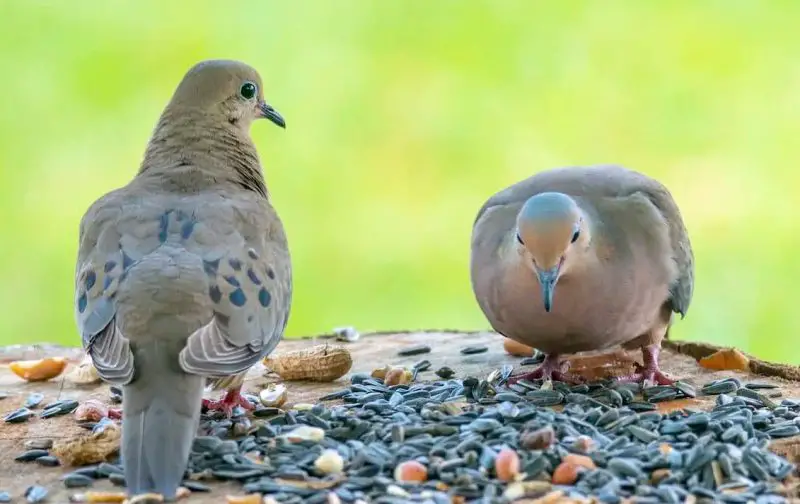
Doves are primarily granivorous, meaning they rely mainly on seeds. Their digestive system is specialized to process small, hard seeds efficiently. A muscular gizzard helps grind seeds, while mild grit and sand they swallow aid in digestion. This adaptation allows doves to survive in open landscapes where seed-producing plants flourish naturally.
Even though seeds dominate their diet, doves supplement with fruits, greens and insects when available. Young doves, especially nestlings, require higher protein for rapid growth. Parents feed crop milk—a nutrient-rich secretion—and then gradually introduce softened seeds and tiny insects. Adult doves also turn to insects during breeding season to support feather development and maintain strength.
Doves forage by walking and pecking at the ground rather than searching in tree canopies like many other birds. They prefer open areas where they can see predators coming, though they will also feed under shrubs or near forest edges. The wide range of food sources listed below shows how versatile and adaptive these birds truly are.
20 Foods Doves Love in the Wild
1. Millet Seeds
Millet is one of the most favored natural foods for doves. Its small size and high carbohydrate content make it easy to digest and ideal for quick energy. Wild millet appears in grasslands, prairies and open fields.
Doves often forage on the ground beneath millet clusters or pick seeds from dry grass heads. During fall, millet becomes especially important as plants dry and release large quantities of seeds.
This tiny grain helps sustain doves through migration periods and seasonal changes.
2. Sunflower Seeds
Wild sunflower seeds are highly nutritious and prized by doves. Although doves prefer hulled or smaller sunflower varieties, they can still crack open larger seeds using the edges of their beaks.
Doves locate wild sunflowers along rural roads, open fields and edge habitats. They feed on fallen seeds or perch on stalks to access drying flower heads.
These seeds supply essential fats that help doves build energy reserves for winter.
3. Safflower Seeds
Safflower plants grow in dry, open areas where doves frequently forage. Their seeds are high in oil and energy, making them valuable especially during cold seasons.
Doves may crack these seeds from the ground or strip them directly from dried plants. Wild safflower patches often attract multiple dove species.
The seeds help maintain body heat and support reproductive cycles.
4. Ragweed Seeds
Ragweed is a prolific producer of seeds that remain available through winter. Doves gather beneath ragweed plants to pick up the tiny seeds scattered on the ground.
The seeds are abundant in disturbed soils, farmlands and roadsides. Doves take advantage of these natural seed banks during late fall.
Ragweed seeds become a major food for doves when other plant sources fade.
5. Foxtail Seeds
Foxtail grasses create dense patches of seeds that doves feed on throughout late summer and fall. These seeds cling to tall stems, making them easy to access.
Doves perch low on stems or forage along the ground where scattered seeds accumulate. Foxtail fields attract large flocks due to their rich seed production.
Their high carbohydrate content offers quick and lasting energy.
6. Wheat
Scattered wheat kernels from fields or transport routes provide a useful food source. Doves pick up leftover grains after harvest seasons and benefit from the nutrient-rich kernels.
Farmlands often support dove populations due to abundant grain residue. Wheat becomes especially valuable during colder months when natural seeds diminish.
The grain supports flight energy and overall survival in sparse environments.
7. Corn (Cracked or Small Pieces)
Wild doves sometimes feed on broken corn pieces found in fields or along feeding areas used by livestock. They prefer small cracked pieces since whole kernels are too large.
Corn provides carbohydrates and moderate protein. Doves may gather near fields after harvests to consume leftover pieces.
This food becomes uncommon in dense forests but abundant in agricultural regions.
8. Grass Seeds
Grasslands offer numerous types of grass seeds that doves readily consume. They peck fallen seeds from soil surfaces or pick them from low stems.
Native grasses provide year-round food as long as seed heads remain intact. Doves often visit open meadows and lawns for these easy meals.
Grass seeds help sustain doves during transitional seasons.
9. Pine Nuts (Fallen Pieces)
In forested environments, doves may consume small pine nut fragments found beneath pine trees. While full nuts are too large, broken pieces are manageable.
These nuts offer healthy fats and protein. Doves occasionally mix pine fragments with seeds gathered nearby.
Pine-rich regions help support doves even when grass seeds are limited.
10. Small Berries
Doves eat berries from shrubs such as dogwood, juniper, viburnum and holly. Berries provide hydration, vitamins and antioxidants.
During late summer and fall, berry-producing plants become essential feeding hubs. The soft fruits allow doves to digest them easily.
Berries also play an important role in supporting doves during molting seasons.
11. Wild Grapes
Wild grapes are abundant along forest edges, trail borders and riverbanks. Doves consume both ripe and slightly shriveled grapes.
Their soft texture makes grapes easy to swallow, and the natural sugar provides fast energy. Grapes also add hydration when water sources are scarce.
These fruits appear seasonally, attracting doves in late summer.
12. Elderberries
Elderberry bushes produce clusters of small black or red berries that doves love. These fruits ripen in late summer and remain available well into fall.
Doves pick these berries directly from branches or forage beneath shrubs where fruit has dropped. Their nutrient density supports overall health.
Elderberries are particularly important for fledglings learning to forage.
13. Maple Seeds
Maple trees shed winged seeds that twirl to the ground in large numbers. Doves peck the seeds open to access the small kernels.
These seeds appear in late spring and early summer, providing seasonal food before many summer plants begin producing fruit.
Their availability across urban and wild environments makes them a reliable resource.
14. Elm Seeds
Elm seeds are paper-thin and easy for doves to consume. After release, they blanket the ground under trees, creating ideal foraging opportunities.
Doves often gather in groups to eat elm seeds, especially during early summer. Soft-textured seeds make them suitable for fledglings too.
Elm-rich areas can support high dove activity during this period.
15. Beetles
Beetles become essential when doves need extra protein, especially during breeding. Adult doves forage on the ground or poke under leaves to find beetles.
These insects contribute to feather health and muscle development. Doves may consume whole beetles or break larger ones apart.
Protein sources like beetles support rapid chick growth.
16. Caterpillars
Caterpillars are soft-bodied insects that provide valuable protein and moisture. Doves actively search for them during spring and early summer.
Parent doves feed caterpillars to nestlings, especially during their first weeks of life. The larvae’s soft texture makes them easy for young birds to digest.
Caterpillar-rich environments strongly benefit dove populations.
17. Ants
Ants are plentiful year-round and are an easy catch for doves. Doves pick ants from soil mounds, leaf litter and foundation edges in natural habitats.
Ants provide steady protein and trace nutrients. Although small, they help diversify the diet, especially for juveniles.
Doves use quick pecks to gather them efficiently.
18. Snails (Small, Soft-Shelled)
Doves occasionally consume small snails, particularly those with soft or thin shells. These snails provide calcium and moisture.
Calcium is especially important during egg-laying season. Doves may search moist soil or shaded areas where snails thrive.
This food is not common but becomes important at specific times.
19. Insect Larvae
Larvae found beneath bark, inside rotting logs or in rich soil offer concentrated protein. Doves break into soft wood or peck at crevices to locate larvae.
Larvae are vital during nesting season. They support rapid chick development and maintain the health of adult birds.
Rich forest floors provide excellent access to this prey type.
20. Fresh Shoots and Greens
Though not a major part of their diet, doves sometimes consume fresh green shoots, clover or tender leaves to supplement nutrients.
These greens help digestion and provide hydration during hot weather. Doves peck at low-growing plants in fields or lawn edges.
Greens are especially helpful when seed availability is low.
FAQs About What Do Doves Eat
What do doves eat the most?
Mostly seeds such as millet, foxtail, ragweed and grass seeds.
Do doves eat insects?
Yes. Insects are important during breeding seasons.
Do doves drink water?
Yes. They drink regularly and often use shallow sources.
Do doves eat fruit?
They eat berries, wild grapes and other soft fruits.
Can doves digest hard seeds?
Yes. Their gizzard grinds seeds efficiently.
Do baby doves eat seeds?
Not at first. They eat crop milk and later softened seeds and insects.
Do doves migrate?
Most remain year-round, depending on region.
Do doves eat from feeders?
Yes. They enjoy millet, safflower and sunflower seeds.
Are doves herbivores?
Primarily granivores, but they also eat insects.
What foods help doves survive winter?
High-fat and abundant seeds, plus dried berries.
Final Thoughts
Doves may appear gentle, but their diet reflects strong adaptability and resilience. Understanding what doves eat highlights how these birds thrive across seasons through a balance of seeds, fruits and insects. The 20 foods listed here show how doves survive in various environments—from grasslands to suburban gardens—by taking advantage of whatever nature provides. Their diet supports their peaceful behavior, strong flight muscles and year-round presence, making them valuable members of many ecosystems.


